- Kenmore refrigerator water filters
- Whirlpool refrigerator water filters
- Samsung refrigerator water filters
- GE refrigerator water filters
- LG refrigerator water filters
- Frigidaire refrigerator water filters
- KitchenAid refrigerator water filters
- Maytag refrigerator water filters
- Kenmore Elite refrigerator water filters
- Estate refrigerator water filters
- GE Profile refrigerator water filters
- Amana refrigerator water filters
- Bosch refrigerator water filters
- Dacor refrigerator water filters
- Electrolux refrigerator water filters
How to replace a riding lawn mower ignition coil
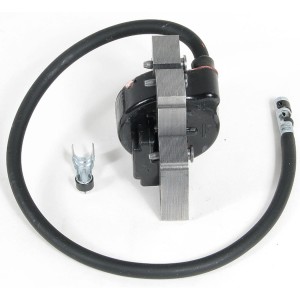
This DIY repair guide explains how to replace the ignition coil on a riding lawn mower. The ignition coil produces the energy that creates the spark at the spark plug. Use a spark plug tester to check for spark when you turn the key. If not, it's likely the ignition coil isn't working. Replace a failed ignition coil using a manufacturer-approved riding lawn mower part.
Use these steps to replace the ignition coil on Briggs & Stratton engines that power Craftsman, Husqvarna, Toro, MTD, Troybilt, Murray, John Deere, Snapper, Ariens, Poulan and Weed Eater riding mowers and lawn tractors.
Quick links
Video
Instructions
Tools required
Wrench set
Feeler gauges
Work gloves
Repair difficulty
Time required
30 minutes or less
Repair difficulty
Time required
30 minutes or less
Replacing an ignition coil on a riding lawn mower
This video explains how to replace the ignition coil on a riding lawn mower.
Instructions
- 01.
Disconnect the battery
Park the tractor on a level surface and set the parking brake.
Turn the ignition switch off and remove the key.
Wear work gloves to protect your hands.
Lift the seat.
Remove the bolt connecting the negative cable to the battery and tuck the cable away from the battery so it doesn't touch the battery post.
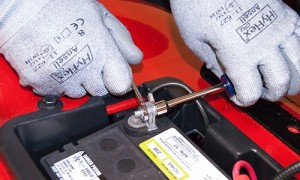
PHOTO: Disconnect the negative battery cable.
- 02.
Remove the engine blower housing
Lift the tractor hood.
Remove the air duct mounting screws and pull off the air duct.
Turn each air filter cover retaining knob counterclockwise and pull off the air filter cover.
Remove the air filter.
Remove the air filter housing screw.
Remove the front and rear blower housing mounting bolts and lift off the blower housing.
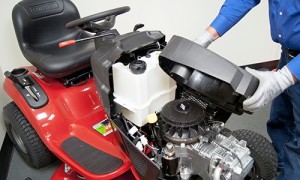
PHOTO: Lift off the blower housing.
- 03.
Remove the old ignition coil
Disconnect the spark plug wire and pull it out of the engine bracket.
Turn the flywheel so the magnet points away from the ignition coil.
Remove the ignition coil mounting screws.
Lift the ignition coil and disconnect the kill wire.
Remove the ignition coil.
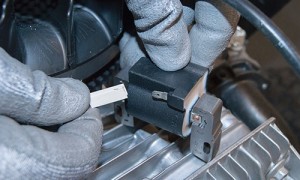
PHOTO: Disconnect the ground wire.
- 04.
Install the new ignition coil
Transfer the spark plug boot from the old ignition coil to the new one.
Connect the kill wire to the new ignition coil.
Position the new ignition coil on the engine and loosely install the 2 mounting screws.
Pull the coil away from the flywheel and tighten the mounting screws.
Turn the flywheel so the magnet aligns with the ignition coil.
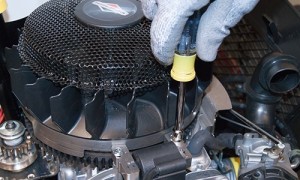
PHOTO: Install the new ignition coil.
- 05.
Set the ignition coil air gap
Insert the feeler gauge. The correct size for most engines is 0.011-inches.
While holding the feeler gauge in position, loosen the mounting screws to allow the magnet to pull the coil to it.
Tighten the mounting screws.
Turn the flywheel by hand and remove the feeler gauge.
Route the spark plug wire through the engine bracket.
Connect the wire to the spark plug.
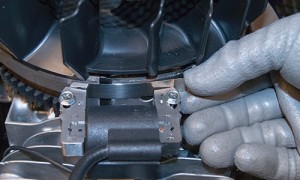
PHOTO: Set the ignition coil air gap.
- 06.
Reinstall the engine blower housing
Position the blower housing on the engine and align the air diverter in the housing.
Install the blower housing mounting bolts.
Install the air filter housing screw.
Install the air filter and air filter cover.
Install the air duct and attach it with the mounting screws.
Lower the tractor hood.
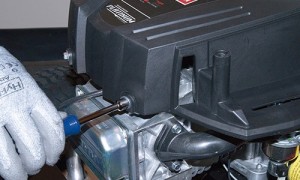
PHOTO: Reinstall the blower housing.
- 07.
Reconnect the battery
Reconnect the negative cable to the negative battery terminal.
Lower the seat.
Warning: Undertaking repairs to power lawn-care equipment can be hazardous. Use the proper tools and safety equipment noted in the guide and follow all instructions. Do not proceed until you are confident that you understand all of the steps and are capable of completing the repair. Some repairs should only be performed by a qualified technician.
Most common symptoms to help you fix your riding mowers & tractors
Choose a symptom to see related riding mower and lawn tractor repairs.
Main causes: faulty battery, bad alternator…
Main causes: damaged cutting blade, worn deck pulley, damaged mandrel pulley, loose fasteners on mower deck components…
Main causes: damaged tie rods, bent or worn wheel spindle, worn front axle, damaged sector gear assembly…
Main causes: worn or broken blade belt, broken belt idler pulley, blade clutch cable failure, bad PTO switch, damaged ma…
Main causes: punctured tire or inner tube, leaky valve stem, damaged wheel rim…
Main causes: engine overfilled with oil, leaky head gasket or sump gasket, damaged carburetor seals, cracked fuel pump, …
Main causes: clogged carburetor, damaged flywheel key, dirty spark plug, stale fuel, improper valve lash, engine needs a…
Main causes: shift lever needs adjustment, neutral control needs adjustment…
Main causes: worn or broken ground drive belt, bad seat switch, transaxle freewheel control engaged, transaxle failure, …
Most common repair guides to help fix your riding mowers & tractors
These step-by-step repair guides will help you safely fix what’s broken on your riding mower or lawn tractor.
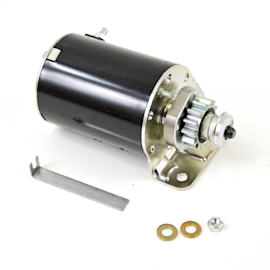
How to replace the starter motor on a riding lawn mower
If you hear the solenoid click but don’t hear the starter motor spin when you turn the key, follow these steps to replac…
Repair difficulty
Time required
30 minutes or less
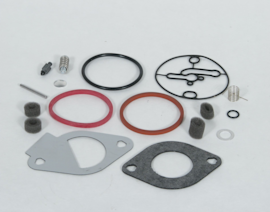
How to rebuild a riding lawn mower carburetor
Get your sputtering carburetor running smoothly in 60 minutes.…
Repair difficulty
Time required
60 minutes or less
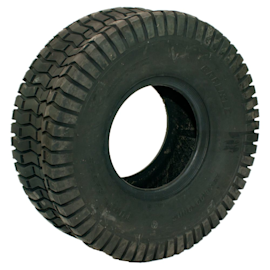
How to replace a riding lawn mower rear tire
Your mower can’t run on a damaged rear tire. Here’s how to install a new one.…
Repair difficulty
Time required
60 minutes or less
Effective articles & videos to help repair your riding mowers & tractors
Use the advice and tips in these articles and videos to get the most out of your riding mower or lawn tractor.

Learn about all the convenient features on our Sears PartsDirect website that make your parts purchases easier.…

Get answers to frequently asked questions about Sears and Sears PartsDirect.…
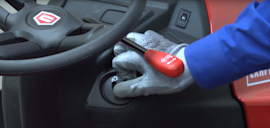
Check the starter solenoid, starter motor, wiring, battery and engine.…